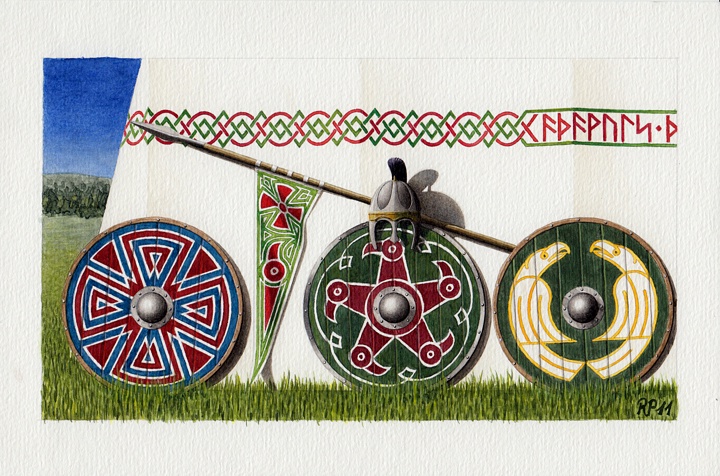
Here you can find a few pictures I’ve drawn or painted up to now on Gothic subjects — you might already know them from where I’ve used them elsewhere. The newest are on top.
Watercolour, 21 · 12 cm², 2011. — An essay on Gothic shield figures and ornamentation, including the subject of my computer based picture “Shield and Spear of the Ancient Goths.” Antetypes for the shields were among others those from the Notitia Dignitatum, and with the tent I’ve had this film scene in mind (making the image continue my series of ‘tolkienesque pictures’). The crosses’ special shape is documented by Migration Period gold crosses, and the rotating eagle motif by fibulae like these here. The spangenhelm is typical for late antiquity. The long lance with pennant — the ‘contus’ — is described in Herwig Wolfram’s History of the Goths.

Computer based work, 14 · 18 cm², 2011. — A book illustration in the style of a copperplate print which I’ve made ‘in reserve’ for later use. The rest of the page serves to frame the image properly. The text is taken from the German Wikipedia; its rest shimmers from the paper’s backside. Anachronistic at this picture is above all the depiction of the spangenhelm — in 1910, from when the print seems to be, the sight of the Germani was still dominated by winged helmets and fur aprons with metal braces. For a more detailed description of the displayed content see my above watercolour “Winner Shields from Ataulf’s Contest”.

Watercolour, 21 · 12 cm², 2010. — “Wilred the Explicator,” a Gothic priest explaining the Gospels to his fellow Goths. For a long time the Goths adhered to Arianism, i. e. a Christian denomination deeming the nature of Christ not alike, but only akin to God Father’s nature (and differing from Catholicism in some other points, too). The name “Wiljariþ” I took from the Naples deed, while the attribution ‘sa Skeirjands’ is leaned on the Skeireins Aiwaggeljons þairh Iohannen, a Gothic commentary on the Gospel of St. John. The picture’s title doesn’t necessarily mean that the displayed scene had to take place in northern Italy — it could have befallen anywhere from the Iberian Peninsula to Illyria.
This image serves as an illustration for my Gothic Readings. It’s the first of my planned series of ‘tolkienesque pictures’ — for example, I’ve reduced the architecture’s style a lot so as to make it impossible to recognise at first sight whether it’s about Mediterranean Pre-Romanesque or Peter Jackson’s Gondorian Style. Moreover, this picture is the first whose preparatory drawing I’ve solely made by computer and then printed in fine lines to the paper. This saves a lot of rubbing and fuzzing the paper.
